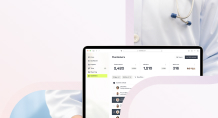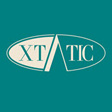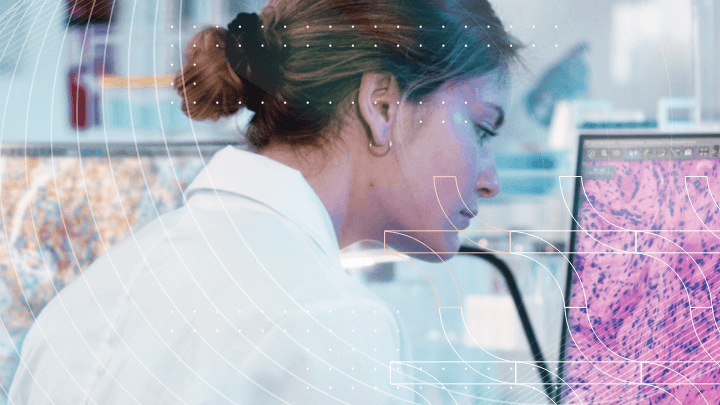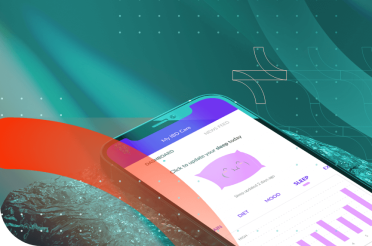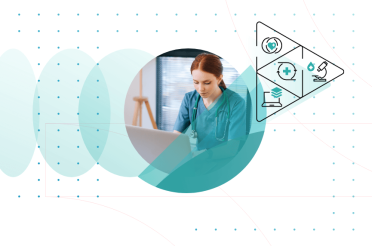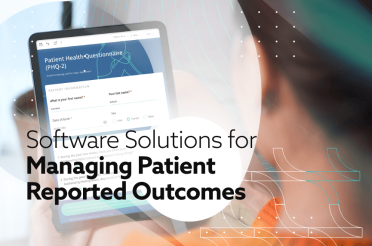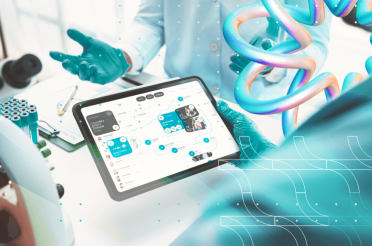With the ever-newer healthcare software, pathology labs have begun testing a wide variety of powerful AI applications to automate workflows, improve functionality, or out-compete other labs.
The global digital pathology market is expected to increase from approximately USD 740.26 million in 2021 to approximately USD 1738.82 million by the end of 2028.
Below, you will learn more about some of the modern pathology software solutions utilized today.
AI-Powered Image Analysis in Digital Pathology
Artificial Intelligence (AI), when applied to image analysis in the field, is the integration of software to analyze pathology images. The key function of the AI is to use its pattern recognition and automation capabilities to assist pathologists in their workflow.
While the traditional image analysis using only the human eye is tried and tested, it has significant drawbacks:
- It relies on the subjective analysis of data by physicians, subject to human error or inter-observer variability. Such errors can be damaging to the reputation of a pathology lab.
- Pathologists need to check microscopic slides manually. Such processes are time and labor-intensive. These difficulties can raise costs or force pathology laboratories to focus on a smaller number of projects.
When applying AI in healthcare and image analysis, these drawbacks can be addressed intelligently and in the long term.
Benefits of introducing AI
Artificial Intelligence can alleviate many of these concerns and provide the following key benefits:
- Increased accuracy and efficiency: AI can provide consistent and precise interpretation of pathology images and digital slides. Once trained, the software can identify patterns, small changes, or abnormalities in pathology images. For example, detecting anomalies in the tissue of patients can ensure an accurate diagnosis of malignant cells.
- Reduced turnaround time: Rather than manually observing glass slides, the AI can automate much of the process. One example is to scan images taken of each field of view of a given microscopy slide and stitch them into one digital file in a process called Whole Slide Imaging.
Another use is for AI-powered image analysis to screen a wide array of data and prioritize cases that need urgent attention or high expertise. As a result, pathologists can focus their efforts and improve their efficiency, reduce costs and output. This ensures quicker and better patient outcomes.
AI is a great tool but with some limitations
Having all of these benefits in mind, AI is only a tool in diagnostics and cannot fully replace humans. Researchers need to account for the fact that one of the drawbacks of AI currently is its lack of generalizability.
What is generalizability?
AI systems are frequently trained on particular datasets, which could not fully capture the variety observed in clinical practice or patient records. As a result, these AI models may perform less well when used on fresh datasets or with distinct populations, producing unreliable or inconsistent outcomes.
As AI development is new such drawbacks are inevitable but laboratories already have solutions:
- Using diverse and representative training datasets: This entails combining pictures from several organizations, several kinds of scanners, and a range of patient demographics.
- Continuous learning and adaptation: This means adding fresh slide imaging data to the AI model regularly to improve its accuracy and performance in various environments.
- Cross-validation: involves evaluating the model on separate validation and test datasets that were not used during training, ensuring that the performance metrics are reliable and reflective of real-world scenarios.
Consequently, AI is one of the main ways of increasing workflow efficiency. Some startups in the area are – Proscia, Tiger Health Technology and Nucleai. Going hand in hand with the use of this digital pathology solution is the Augmented Reality (AR) applications.
Augmented Reality Applications In Digital Pathology
Augmented Reality (AR) overlays digital data on the real environment to provide a more engaging interaction. AR is a development revolutionizing the way pathologists view and examine tissue samples, enabling improved surgical planning, education, research, and diagnosis.
This is a completely new approach to the pathology department as there is no traditional analogue to which AR can be compared. Nevertheless, this new system can provide several benefits.
Enhancing Visualization and Diagnostics
Immersive visualization is one of AR’s main uses in digital pathology. With augmented reality (AR) technology, pathologists can directly overlay digital annotations, 3D models, and other relevant information on actual slides. This feature offers a more comprehensive perspective, which improves understanding of complicated tissue architecture and disorders.
Real-time image analysis is another benefit to consider. When analyzing tissue samples, pathologists can get immediate feedback and recommendations for diagnoses by combining augmented reality (AR) with AI-powered image analysis tools.
Applications in Education and Training
Augmented reality is one of the best tools for creating interactive learning experiences.
Applications for augmented reality (AR) in pathology teaching let students study and engage with virtual pathology specimens in a three-dimensional setting. Teachers, on the other hand, can utilize augmented reality (AR) to build virtual classrooms where students can interact with quizzes and debates, view comprehensive annotations, and edit and analyze digital presentations. This experiential learning method improves the learning process by simplifying and retaining difficult concepts.
Another way to implement the technology into education and training is through virtual microscopy sessions.
Virtual reality (AR) enables remote access to digital pathology slides for students to see and evaluate during these sessions. For universities with limited access to physical slides or microscopes, this capacity is especially helpful.
Discover how we can help outsource Healthcare projects efficiently Speak to an expert today, and see how our on-demand IT talent and augmented teams can efficiently deliver value at every step of your roadmap.

The issue of costs
The high expense of the technology is one major disadvantage of using Augmented Reality (AR) applications in digital pathology. AR system creation, implementation, and upkeep demand a significant cost outlay. Many pharma companies or researchers may decide not to integrate AR into their diagnostic procedures or in the education of experts now but wait for the technology to become cheaper.
However, there are still ways of implementing the tech even with these limitations in mind:
- Phased implementation: Starting with pilot projects and buying equipment over time may be a way to both save on up-front costs and test the tech.
- Collaboration: Sharing the costs with other institutions by investing jointly may be a way for several smaller labs and educational institutions to acquire the equipment and create common projects at the same time.
Of course, it will take some time for the tech to become widely available to every institution. Some startups include – Augmentiqs, ARSPECTRA or Meshcapade. Yet, laboratories do not need large capital to benefit from pathology software as there are solutions that are intended to save cost in the first place.
Cloud-Based Pathology Solutions
The basic premise of this solution is to use cloud storage and processing to improve accessibility, scalability, and cost-effectiveness through a digital provider. These technologies aim to assist pathologists, healthcare facilities, and patients by enabling the processing and sharing of digital pathology pictures and related data.
Generally, the traditional approach of pathology means investing significant capital in on-premises systems, room to hold said systems, and infrastructure to handle the handling of large volumes of data. Said systems then require maintenance and periodic replacement as ongoing costs.
Instead, a laboratory can opt to digitize some or most of its tasks through cloud software and enjoy some or all of these benefits.
Scalability and Flexibility
Cloud-based solutions make it easy for pathology labs to grow their operations since they provide nearly infinite processing and storage capacity. Scalability like this is especially helpful for organizations that are handling bigger datasets and growing caseloads.
Additionally, pathologists can access data and applications from any location with an internet connection thanks to cloud-based solutions’ flexibility. Because of this remote accessibility, pathologists can review and analyze slides, work with colleagues, and give consultations without being restricted to a physical lab. Ultimately, this means meeting the needs of a modern, mobile workforce.
As a result, remote labs can provide immediate services to clients or other institutions, regardless of geographical or equipment constraints.
Enhanced Collaboration
Cloud-based pathology technologies let researchers, doctors, and pathologists collaborate more effectively. These technologies let numerous people access and work on the same cases at once by storing digital pathology images and data in a centralized cloud repository.
Real-time insight sharing, peer evaluations, and second opinions are made possible by this digital pathology workflow, which improves patient outcomes and leads to more accurate diagnoses.
Subscription Instead of Maintenance
Pathology labs can significantly lower capital costs related to buying and maintaining gear and infrastructure by implementing a cloud approach. Rather, they opt for a more predictable and controllable subscription or usage-based payment approach for cloud services which are considerably cheaper than on-premise software.
Furthermore, by eliminating the requirement for IT staff to maintain and support on-premises systems, cloud solutions can reduce operating costs. Cloud providers take care of security, upgrades, and system upkeep. This frees pathology labs to concentrate on their primary business operations rather than managing IT.
Privacy concerns
As with every cloud-based technology, the question of privacy needs to be addressed seriously. The online storage of pathology and sensitive patient data raises questions about data breaches, unauthorized access, and compliance with strict healthcare standards.
Pathology data is extremely secret, and any disclosure of this information might have dire consequences, including financial penalties, loss of patient trust, and legal ramifications.
Having that in mind, any digital storage, whether on-premises or cloud-based, is subject to cyber-attacks. Therefore, any pathology lab software must implement strict security measures.
To minimize risks and ensure secure access to data, medical laboratories need to take the following measures:
- Choosing reputable cloud service providers: This includes working with providers that adhere to industry standards and certifications, such as ISO/IEC 27001 for information security management and SOC 2 for service organization control.
- Implementing strong data encryption: To prevent unwanted access, data must be encrypted while it is in transit and at rest.
- Disaster recovery and backup plans: To lessen the effects of data breaches and other security incidents, it is essential to have a strong disaster recovery and backup plan.
As a result, cloud-based are one of the solutions that can be utilized by every lab, big or small. Some new players in the field include – Aiforia, AISight and Tiger Health Technology A software of similar use to every establishment is also the billing software.
Software Billing Services
The software does more than automate one of the routine tasks of a pathology laboratory. Billing services help remove administrative burdens by automating the filing of claims or ensuring regulatory compliance.
Traditional billing on paper or run by individuals in a digital format is subject to the same restrictions as any job operated by humans. First, there are the usual problems with human error, the time-consuming manual handling, and the need to pay an accountant to deal with taxes and other legal questions.
A much simpler alternative is to introduce specialized billing software that can handle most things independently:
- Automated billing processes: most obviously, the automation of billing procedures is one of the software’s main characteristics. Invoices are automatically generated by the program using patient data, billing codes, and the tests that were conducted.
- Insurance claims management: Insurance claim handling is made easier by lab billing software, which automates the submission procedure. It makes sure that insurance companies receive correctly coded and submitted claims, which lowers the possibility of delays or denials. By providing real-time information and tracking claim progress, the program helps laboratories better manage their accounts receivable.
- Compliance and regulatory support: Medical labs are subject to several legal mandates and billing guidelines, for example, the Health Insurance Portability and Accountability Act (HIPAA) in the US. By including these rules within its operations, lab billing software contributes to compliance. To safeguard patient data and uphold regulatory compliance, it offers audit trails, data encryption, and secure access controls.
A small drawback is that there may be upfront costs connected to implementing the software and the workflow will need to be updated to accommodate the software. Issues can arise with the need to retrain employees to use the software or the need to transfer the previous database into the new software
Thankfully, there are pretty easy solutions to most of these issues. A lab can use cloud-based software and only pay a subscription, invite specialists to educate the staff, and later on simply have a specialist on standby to help with issues as they arise. Startups include – CrelioHealth, Invensis or AdvancedMD.
Deliver a world-class Healthcare project–with high-skilled, seamlessly integrated IT talent Learn how from our consultants. We work with clients worldwide.
Conclusion
Currently, there is software that can address most issues that can arise in a pathology lab.
This is valid in all cases when a lab wants to optimize its diagnostic procedures, clinical workflows, or specimen tracking in an attempt to improve patient outcomes. On the other hand, software can be used when the laboratory simply wishes to help with administrative tasks such as case management, and organization or optimize the use of resources.
Whatever the issue and irrespective of the financial capabilities of the pathology lab, the only relevant question is which software will be optimal for the given situation.
With that in mind, talking to a trusted partner who specializes in healthcare software may be the right option. Namely, specialists in healthcare apps like BGO Software would be more than qualified to suggest software solutions for every situation!


